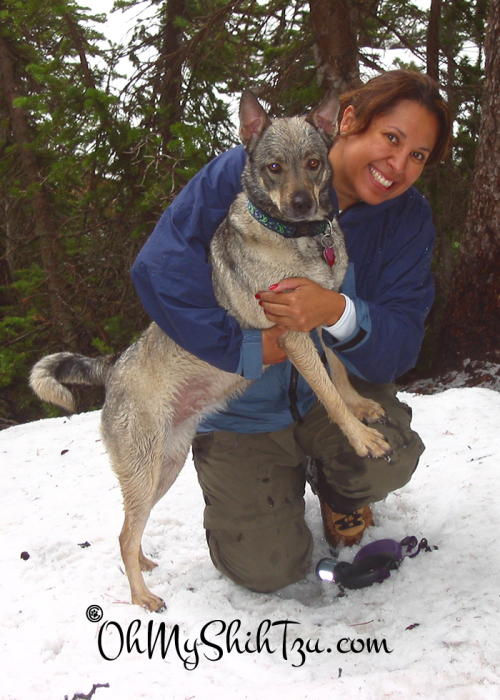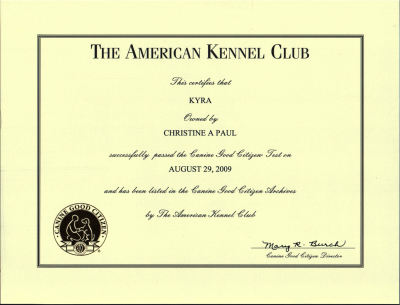Do you have a dog? If so is your dog a Canine Good Citizen? What You don’t know what the CGC test is? Well I’m glad you stopped by today.
The Canine Good Citizen (aka CGC) is a test offered by the American Kennel Club. It is a way to reward dogs who have good manners within their community and at home.
Oh I know what you are thinking, ‘But I have a Mutt we got from our local rescue!’ That is perfect , as this test is open to all dogs of any breed or mix and there is no age limit.

What does the test consist of?
The Canine Good Citizen Test is composed of 10 basic skills every dog should know. They include:
Test 1: Accepting a friendly stranger
This test demonstrates that the dog will allow a friendly stranger to approach it and speak to the handler in a natural, everyday situation. The evaluator walks up to the dog and handler and greets the handler in a friendly manner, ignoring the dog. The evaluator and handler shake hands and exchange pleasantries. The dog must show no sign of resentment or shyness.
Test 2: Sitting politely for petting
This test demonstrates that the dog will allow a friendly stranger to touch it while it is out with its handler. With the dog sitting at the handler’s side, to begin the exercise, the evaluator pets the dog on the head and body. The handler may talk to his or her dog throughout the exercise. The dog may stand in place as it is petted. The dog must not show shyness or resentment.
Test 3: Appearance and grooming
This practical test demonstrates that the dog will welcome being groomed and examined and will permit someone, such as a veterinarian, groomer or friend of the owner, to do so. It also demonstrates the owner’s care, concern and sense of responsibility.
Test 4: Out for a walk (walking on a loose lead)
This test demonstrates that the handler is in control of the dog. The dog may be on either side of the handler. The dog’s position should leave no doubt that the dog is attentive to the handler and is responding to the handler’s movements and changes of direction. The dog need not be perfectly aligned with the handler and need not sit when the handler stops.
Test 5: Walking through a crowd
This test demonstrates that the dog can move about politely in pedestrian traffic and is under control in public places. The dog and handler walk around and pass close to several people (at least three). The dog may show some interest in the strangers but should continue to walk with the handler, without evidence of over-exuberance, shyness or resentment. The dog should not jump on people in the crowd or strain on the leash.
Test 6: Sit and down on command and Staying in place
This test demonstrates that the dog has training, will respond to the handler’s commands to sit and down and will remain in the place commanded by the handler (sit or down position, whichever the handler prefers). The dog must do sit AND down on command, then the owner chooses the position for leaving the dog in the stay. Prior to this test, the dog’s leash is replaced with a line 20 feet long.
Test 7: Coming when called
This test demonstrates that the dog will come when called by the handler. The handler will walk 10 feet from the dog, turn to face the dog, and call the dog. The handler may use encouragement to get the dog to come. Handlers may choose to tell dogs to “stay” or “wait” or they may simply walk away, giving no instructions to the dog.
Test 8: Reaction to another dog
This test demonstrates that the dog can behave politely around other dogs. Two handlers and their dogs approach each other from a distance of about 20 feet, stop, shake hands and exchange pleasantries, and continue on for about 10 feet. The dogs should show no more than casual interest in each other. Neither dog should go to the other dog or its handler.
Test 9: Reaction to distraction
This test demonstrates that the dog is confident at all times when faced with common distracting situations. The evaluator will select and present two distractions. Examples of distractions include dropping a chair, rolling a crate dolly past the dog, having a jogger run in front of the dog, or dropping a crutch or cane. The dog may express natural interest and curiosity and/or may appear slightly startled but should not panic, try to run away, show aggressiveness, or bark. The handler may talk to the dog and encourage or praise it throughout the exercise.
Test 10: Supervised separation
This test demonstrates that a dog can be left with a trusted person, if necessary, and will maintain training and good manners. Evaluators are encouraged to say something like, “Would you like me to watch your dog?” and then take hold of the dog’s leash. The owner will go out of sight for three minutes. The dog does not have to stay in position but should not continually bark, whine, or pace unnecessarily, or show anything stronger than mild agitation or nervousness. Evaluators may talk to the dog but should not engage in excessive talking, petting, or management attempts (e.g, “there, there, it’s alright”).
Courtesy of American Kennel Club
So what do you think? Are you ready to take this challenge and have your dog become a Canine Good Citizen? And did you know that some home insurance companies give discounts on their policies if your dog is a canine good citizen? Wow! What a great incentive of training your dog to be a SuperDog!

What a great post, I always wondered what exactly was involved!
dorysbackyard recently posted…Thoughtful Thoughtless Thursday
Awesome I’m glad to hear that it was informative … it is a great test to have completed for both you and your dog 🙂
Three of my four dogs have their CGC 🙂 and I am an CGC evaluator. I did a short series on my blog about training for each of the test components – I think it’s really important for dogs to have these basic skills :).
Erin @ The Five Dog Blog recently posted…C is for Consistent Cues 🙂
I’m an evaluator too!! But unfortunately none of the other evaluators around where I live will do reciprocal testing… so I only have one tested 🙁